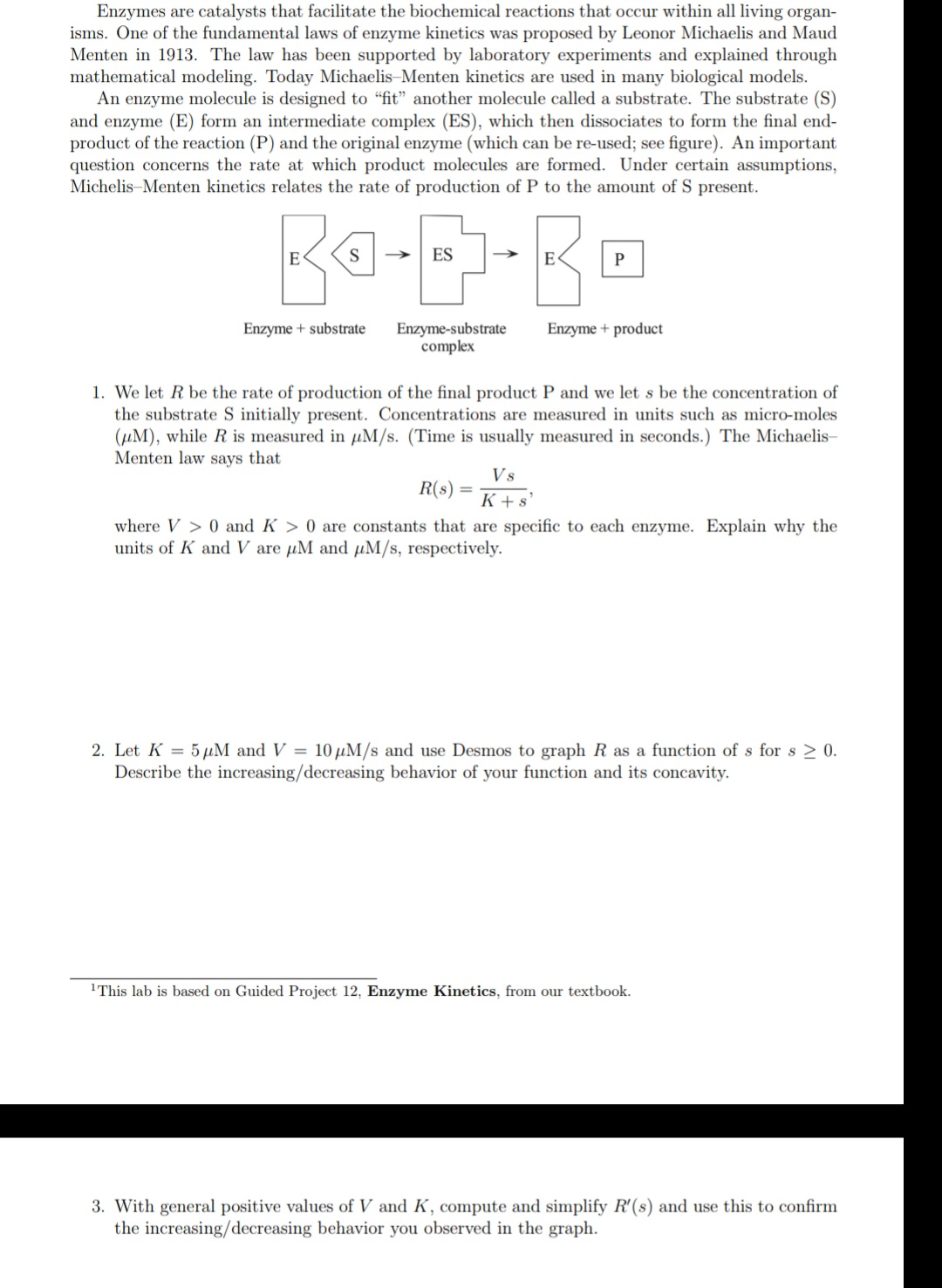3. With general positive values of V and K, compute and simplify R'(s) and use this to confirm the increasing/decreasing behavior you observed in the graph.
3. With general positive values of V and K, compute and simplify R'(s) and use this to confirm the increasing/decreasing behavior you observed in the graph.
Linear Algebra: A Modern Introduction
4th Edition
ISBN:9781285463247
Author:David Poole
Publisher:David Poole
Chapter2: Systems Of Linear Equations
Section2.4: Applications
Problem 28EQ
Related questions
Topic Video
Question
Please answer question 3

Transcribed Image Text:Enzymes are catalysts that facilitate the biochemical reactions that occur within all living organ-
isms. One of the fundamental laws of enzyme kinetics was proposed by Leonor Michaelis and Maud
Menten in 1913. The law has been supported by laboratory experiments and explained through
mathematical modeling. Today Michaelis-Menten kinetics are used in many biological models.
An enzyme molecule is designed to "fit" another molecule called a substrate. The substrate (S)
and enzyme (E) form an intermediate complex (ES), which then dissociates to form the final end-
product of the reaction (P) and the original enzyme (which can be re-used; see figure). An important
question concerns the rate at which product molecules are formed. Under certain assumptions,
Michelis-Menten kinetics relates the rate of production of P to the amount of S present.
S
ES
P
Enzyme-substrate
complex
Enzyme + substrate
Enzyme + product
1. We let R be the rate of production of the final product P and we let s be the concentration of
the substrate S initially present. Concentrations are measured in units such as micro-moles
(µM), while R is measured in uM/s. (Time is usually measured in seconds.) The Michaelis-
Menten law says that
Vs
R(s)
K + s'
where V > 0 and K > 0 are constants that are specific to each enzyme. Explain why the
units of K and V are µM and µM/s, respectively.
2. Let K = 5 µM and V = 10 µM/s and use Desmos to graph R as a function of s for s > 0.
Describe the increasing/decreasing behavior of your function and its concavity.
1This lab is based on Guided Project 12, Enzyme Kinetics, from our textbook.
3. With general positive values of V and K, compute and simplify R'(s) and use this to confirm
the increasing/decreasing behavior you observed in the graph.
Expert Solution
This question has been solved!
Explore an expertly crafted, step-by-step solution for a thorough understanding of key concepts.
This is a popular solution!
Trending now
This is a popular solution!
Step by step
Solved in 3 steps

Knowledge Booster
Learn more about
Need a deep-dive on the concept behind this application? Look no further. Learn more about this topic, calculus and related others by exploring similar questions and additional content below.Recommended textbooks for you

Linear Algebra: A Modern Introduction
Algebra
ISBN:
9781285463247
Author:
David Poole
Publisher:
Cengage Learning

College Algebra (MindTap Course List)
Algebra
ISBN:
9781305652231
Author:
R. David Gustafson, Jeff Hughes
Publisher:
Cengage Learning

Trigonometry (MindTap Course List)
Trigonometry
ISBN:
9781337278461
Author:
Ron Larson
Publisher:
Cengage Learning

Linear Algebra: A Modern Introduction
Algebra
ISBN:
9781285463247
Author:
David Poole
Publisher:
Cengage Learning

College Algebra (MindTap Course List)
Algebra
ISBN:
9781305652231
Author:
R. David Gustafson, Jeff Hughes
Publisher:
Cengage Learning

Trigonometry (MindTap Course List)
Trigonometry
ISBN:
9781337278461
Author:
Ron Larson
Publisher:
Cengage Learning

Big Ideas Math A Bridge To Success Algebra 1: Stu…
Algebra
ISBN:
9781680331141
Author:
HOUGHTON MIFFLIN HARCOURT
Publisher:
Houghton Mifflin Harcourt